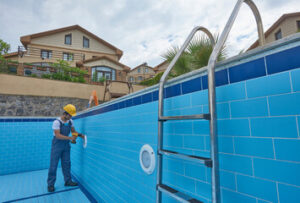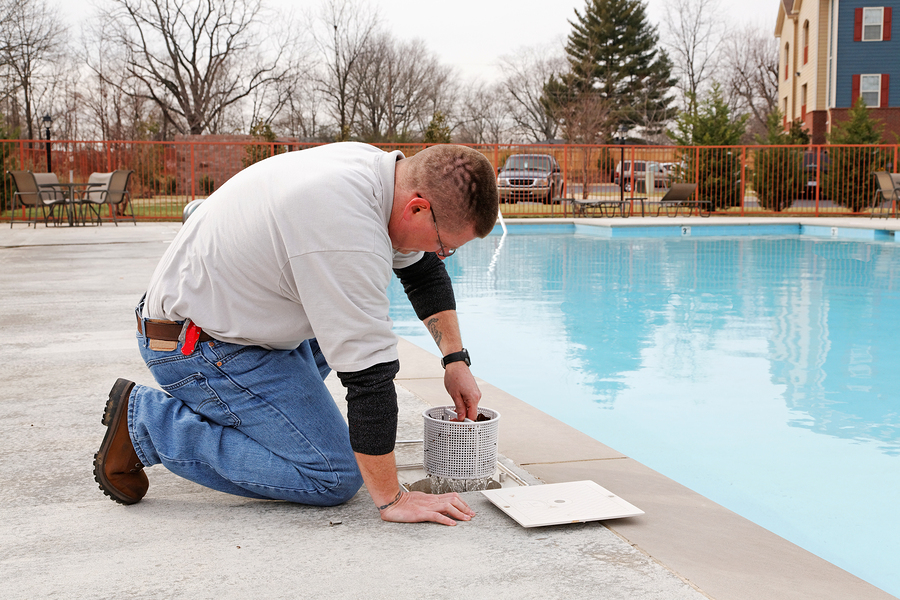A pool is a wonderful addition to any home and can provide an excellent way to stay healthy by swimming. But it’s important to know when to call a professional like Pool Repair for repairs and cleaning.
A leaking pool can damage your equipment, cause chemical imbalances, and, in extreme cases, even corrode the pool’s shell. This is why it’s so important to catch leaks early. While a leak in the plumbing or equipment is often the most difficult to diagnose, many people can do a few simple steps to help find and repair these leaks.
Begin by simply visual inspection, especially around the equipment and pipes. Look for standing water, a muddy or sandy bottom, corrosion around fittings, or gaps between the equipment and the pool deck. Any of these are signs that there is a leak in your system.
Leaks can also be detected by watching the water levels in your pool. A sudden drop in water levels could indicate a leak, though this could also be attributed to evaporation or other factors. To test this, fill a bucket with pool water and mark the level on the outside of the bucket. If the pool water drops below this mark within 24 hours, a leak is most likely to blame.
A good place to start looking for a leak is at the equipment itself, such as the pump, filter, heater or chlorinator. If you think there’s a leak in one of these areas, first shut off the power and then carefully check all the parts to make sure they are all securely in place. Next, run a dye test in the area where you suspect there may be a leak. Using food coloring, sprinkle the dye in the suspected area. If the water leaking from a tear or hole is drawing the dye, it will reveal the location of the problem.
Once you have found a leak, it’s time to work on a permanent solution. If the leak is in a liner tear, you can try duct tape or a vinyl patch kit. These kits usually come with large chunks of blue or clear liner and special underwater vinyl adhesive to ensure a long-lasting, durable fix. If the leak is in a pipe, more advanced methods of leak detection can be used, such as injecting air into a pipe and listening electronically for sounds of bubbles escaping.
Cracks
Structural cracks are a sign that your pool shell may have shifted or deteriorated. These type of cracks are the most dangerous and should be repaired immediately to prevent further deterioration, water loss and possible structural failure in the future. If you notice a large amount of cracking in your pool, it’s important to consult with an experienced local repair expert immediately to help determine the best approach for repair.
Surface cracks, also called cosmetic cracks are generally caused by the weather and sun exposure. They are usually not as serious as structural cracks and should not be considered a major concern. However, if you’re experiencing structural cracks that run vertically and/or horizontally, it’s time to call in a professional for a complete inspection.
There are many ways to repair cracks, depending on the severity and location of the crack. The most basic method is to drain your pool to below the cracked area and sand it, then cut around the crack with a saw equipped with a diamond blade. Next, fill the crack with hydraulic cement and allow it to dry. Once the crack is filled and cured, you can apply a bond coat, followed by mixed polyester putty. Once the putty is cured, you can apply fiberglass and a gel coat.
Another way to repair cracks is by injecting epoxy or polyurethane, although this is not recommended for long-term use. Unlike other types of pool repairs, injection methods don’t address the root cause and will not prevent future cracking.
The best and most permanent solution for structural cracks is to install Torque Lock Structural Staples. These stainless steel staples lock the pool shell together on both sides of the crack like a frankenstein stitch, and provide a strong foundation that can resist future movement. This is a complex repair that requires professional equipment, so it’s best to let an experienced pool repair expert handle this type of severe crack repair. They will also ensure that the cracks are properly inspected and repaired to prevent future issues. This will prevent the cracks from re-opening and require further expensive repairs in the future.
Grout Discoloration
The pool is meant to be a place of serenity and relaxation – but the gleaming tiles on your pool’s walls and floor can quickly lose their appeal if they are covered with unsightly stains, discoloration or tiny cracks. These are some of the most common problems to watch for, and they all indicate that it’s time to call a professional.
Discolored grout often results from microbial growth and moisture accumulation. This is particularly true of glass tile, which are typically exposed to harsh climatic conditions and abrasive pool chemicals.
This discoloration is usually a result of calcium build-up, which can be difficult to remove without the help of a chemical cleaner. A glass tile repair company will likely recommend a chemical solution that can be added to your pool’s regular cleaning routine.
A simple vinegar-water mixture is also a great choice for cleaning your pool’s grout, especially if it’s sealed epoxy. Vinegar is a natural abrasive, and its acidic properties can remove stains and deposits without damaging your grout. It can be applied to a nylon brush for ease of use, or you can even attach it to a drill and save your arms from repetitive scrubbing.
Grout can also become discolored if it isn’t properly installed, or if the grout isn’t regularly maintained. In order to prevent this from happening, it’s important to hire a professional who has extensive experience in the field of pool installation and grouting. They will ensure that the proper amount of grout is used, and that it’s correctly installed. They will also provide you with instructions on how to clean and maintain your grout.
In addition to enhancing the appearance of your pool, well-maintained grout will also elevate your swimming experience and can increase the value of your property when it comes time to sell. Keeping up with your grout maintenance can reduce the need for intensive cleanings, and simple preventative measures like routine scrubbing with a pool brush and ensuring that your water is balanced correctly can go a long way in preventing staining or discoloration.
Light Bulbs
The light fixture in a pool is an important safety feature that keeps your family and friends safe. However, it may need to be replaced when the bulb becomes dim or the water leaks out of the fixture. Fortunately, changing the light in your pool is easier than you might think. Before you start working on your pool’s light, it is important to turn off the power supply at your circuit breaker so that there is no risk of electrocution. Next, collect the tools and equipment that you will need for this project. This includes a screwdriver, replacement bulbs and any other equipment that is specified by the manufacturer of your pool light.
The first step in replacing a pool light is to unscrew the old one from the niche in the wall of the pool. Once the screw is removed, place it someplace safe so that it doesn’t roll away and get lost (a shirt pocket is a great option). Once you have the fixture outside of the pool, use a flashlight to help guide you if you need to see inside the niche in order to unscrew the remaining screw. Once the fixture is fully unscrewed, carefully remove it from the niche and take a close look at both the cord and the fixture itself. If there are any cracks or damage to either of these, you should consider replacing the entire light fixture rather than just the bulb.
When purchasing a new pool bulb, you should pay special attention to the wattage of the bulb. Different types of bulbs have different wattages that will determine how bright they are and how long they last. Ideally, you will find out the exact wattage of the existing light by reading the label on the fixture or by checking the manufacturer’s website. This will save you time and money by ensuring that you are purchasing the correct wattage.
Once you have the right wattage, you can purchase your pool light bulb at your local pool-supply store or online. If you are having trouble finding the perfect bulb, consider asking for assistance from a knowledgeable employee or contacting your pool’s manufacturer directly. When you are ready to install the new bulb, carefully insert it into the fixture and tighten the bezel around the lens to prevent water from leaking out. Finally, make sure the gasket is properly sealed before returning the fixture to the niche and reinstalling it in your pool.

